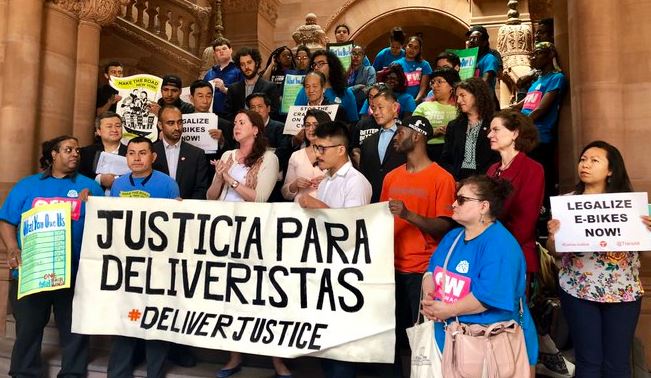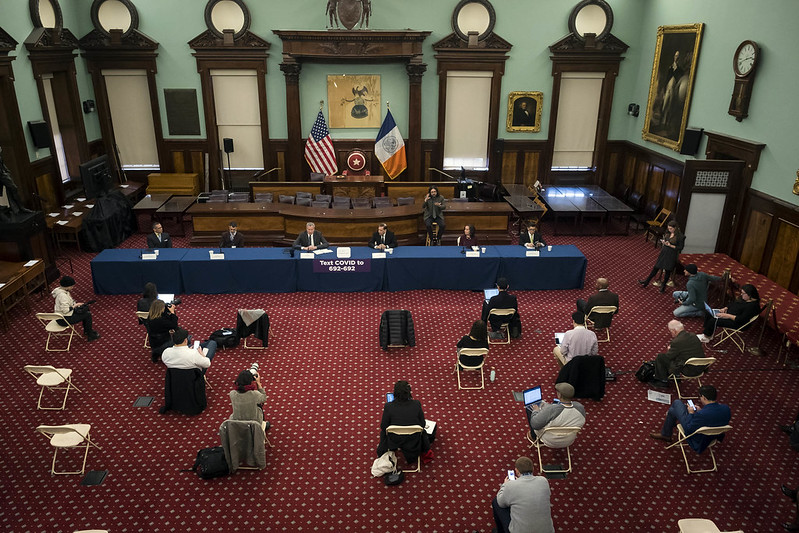Coronavirus Crisis Spotlights Importance of Food Delivery Workers and Need to Legalize Their E-Bikes

The push for legalizing e-bikes continues (photo: @nily)
Right now, our colleagues in Albany can deliver immediate justice and help keep New York fed and moving during a time of crisis. They must legalize electric-bikes in the state budget being finalized right now.
As part of the effort to slow the spread of COVID-19, the de Blasio and Cuomo administrations announced this week that restaurants, bars, and cafes would close for dine-in customers, but that take-out and delivery would remain available. This move made it clear that New York City’s food delivery workers, a workforce largely comprised of low-paid immigrant Americans from China and Latin America, would be shouldering a large burden, and would soon become a lifeline for potentially millions of New Yorkers during the pandemic.
That is why we are renewing, with urgency, the call for the legalization of e-bikes which most delivery workers use to complete their rounds.
About three-quarters of New York City’s 40,000 food delivery workers rely on throttled e-bikes, which are technically illegal to operate in New York because of a gray area in the state’s vehicle code. These e-bikes, which are different from the pedal-assist e-bikes deployed by Citi Bike, are critical equipment for delivery workers, many of whom are older than 60 and work 10-12 hour days. Try doing that job on a traditional bike and you might not last half as long.
Most e-bikes are legal in most states, including right across the Hudson in New Jersey. Yet here in the city, where making food deliveries makes the most sense on bicycles as opposed to cars, they are still somehow illegal. Most delivery workers’ median hourly wage is about $10. When stopped by police they are routinely ticketed upwards of $1,000 and have their bikes confiscated. When a worker’s bike is confiscated it means they can’t work to pay the fine, let alone feed their family.
However, while the de Blasio administration heard our demand to decriminalize e-bike enforcement in tandem with the coronavirus-related limitation on food service, there is no guarantee that this will be permanent after the crisis is over. To criminalize their work after such public service, even after they risk their lives and their families’ lives during this pandemic, would be a travesty of justice.
That is why we are calling on our elected leaders in Albany to (once again) pass and enact legislation to create a legal framework for e-bikes. Last year, the New York State Legislature passed legislation sponsored and impressively championed by Senator Jessica Ramos and Assemblymember Nily Rozic that would have legalized e-bikes and given municipalities throughout New York the authority to determine their use. Governor Cuomo vetoed that bill citing safety concerns, but he reignited the conversation with an admirable e-bike legalization proposal of his own in January.
The push to legalize e-bikes has a broad base of support, not only from groups fighting for immigrant and workers’ rights like Make the Road New York and the Legal Aid Society, but also environmental and transportation safety groups, like the New York League of Conservation Voters and Transportation Alternatives.
We are counting on all state legislators and Governor Cuomo to unite and pass a budget that guarantees permanent relief for delivery cyclists. Crises can lead to social change, and we expect one positive outcome of the era of social distancing will be a newfound social solidarity with the hard-working delivery workers who keep our city fed, and an end to the shameful police harassment they have weathered for too long.
By ensuring e-bike legalization right now more than 40,0000 hard-working New Yorkers would not have to fear retribution and confiscation of their tools during and after the coronavirus crisis, as they, with their own bodies on the front line, continue to feed New Yorkers, and keep restaurants, farmers, and other companies in business in these trying times.
***
City Council Members Carlos Menchaca and Margaret Chin represent portions of Brooklyn and Manhattan, respectively. On Twitter @cmenchaca & @CM_MargaretChin.
***
Have an op-ed idea or submission for Gotham Gazette? Email This email address is being protected from spambots. You need JavaScript enabled to view it.
New for New York City: What Solidarity Looks Like Amid Coronavirus Outbreak

social distancing amid coronavirus is key (photo: Ed Reed/Mayoral Photography Office)
New Yorkers have a particular way of showing solidarity. After the terrorist attacks of September 11, 2001, resuming normal life was an act of bravery. We would not be derailed. We would carry on. As tragedies have struck other cities and countries, the language of solidarity, arguably the language of coping, has stayed the same. In essence, we come together, try to restore a sense of normalcy, and move forward.
The rapid spread of the new coronavirus, COVID-19, has rattled the global economy and disrupted everyday life. The Dow Jones Industrial Average had its worst day since 1987. Universities across the country -- including New York University, Columbia, and the CUNY and SUNY systems -- have cancelled in-person classes and moved instruction online; New York City public schools are switching to remote learning, as well.
Broadway shows are shuttered through at least April, and the Metropolitan Museum of Art has closed its doors. Late-night talk shows are filming without audiences, the NBA and NHL seasons are suspended, the start of baseball season is on hold, and the New York City Half Marathon is cancelled. Subway ridership has plummeted, all restaurants are reduced to takeout/delivery only, and the streets feel eerily quiet. Mayor de Blasio is now pushing for a “shelter in place” order.
On a visceral level, this feels like the opposite of what we should be doing. What about showing that we are better than this, that life can go on, that we are resilient? What about showing that we will not be cowed? Even after September 11th, Broadway shows reopened two days later. But the reality of this global pandemic demands a different sort of solidarity, one that feels at odds with how we would normally react when facing such a threat. Maintaining our routines and showing we are unafraid is pointless and will not help thwart this virus; instead, it would put us all at greater risk.
And so, our New York City solidarity needs to take a new form: social distancing, a phrase that has quickly become part of our daily lexicon. For creatures as social as we are, staying at home is difficult, especially in such a dense city. We are a society of people who find comfort in coming together and taking action, who are used to being crammed together in small spaces and making the best of it; robbed of these tools -- we cannot join marches or attend vigils like we normally would, we can’t even ride the subway like usual -- we feel trapped. Keeping our distance makes it feel like we are losing, but it has been shown to work when it comes to flattening the curve.
For now, our courage will need to remain unseen, our solidarity taking the form of empty subway cars and closed museums. For a city of people used to supporting one another by showing up, this is deeply unsettling, at odds with how we have been taught to fight back.
The psychological, physical, and economic toll social distancing will take on many New Yorkers may be devastating. A coalition of New York City landlords has pledged not to pursue coronavirus-related evictions, de Blasio is trying to keep human services nonprofits running, and senior centers are cancelling all social programming, serving meals instead. Meanwhile, Congress passed a $100 billion relief package and is working on a $1 trillion economic stimulus. Meanwhile, housing advocates nationwide are calling for a moratorium on rent, mortgage, and utility payments to help those out of work cope with their new fiscal reality.
Despite all these efforts, the mental and economic hardship caused by this pandemic will have long-lasting ramifications. It may be tempting for people in low-risk categories -- namely, young people with no underlying health concerns -- to go about life as normal. But if we keep carrying on like nothing is happening, we put the well-being of the most vulnerable among us at risk. Doctors are sounding alarms that our hospitals may be overwhelmed. We all need to do our part to minimize the spread of this virus, taking seriously the calls to avoid crowded places and stay inside even if it feels like the cowardly thing to do.
If we want to show solidarity in a more active way, perhaps we can leave some toilet paper and hand sanitizer for our fellow New Yorkers. We can also make ourselves available to help vulnerable neighbors in self-quarantine with no one to bring them food. Beyond that, though, we New Yorkers are slowly learning a new language for our solidarity: staying home.
***
Benjamin Heller is a graduate student at NYU’s Robert F Wagner School of Public Service. On Twitter @BenjaminHeller0.
***
Have an op-ed idea or submission for Gotham Gazette? Email This email address is being protected from spambots. You need JavaScript enabled to view it.
Environmental Justice, Clean Energy, and the Truth about Indian Point

renewable energy and the future of New York power (photo: Mayor's Office)
In a recent Gotham Gazette column, Richard Webster, legal director for Riverkeeper, writes that “New York Has Already Moved Beyond Indian Point Nuclear Power; Here’s Where We’re Headed.” While Riverkeeper, the Westchester-based environmental group that has spearheaded the decades-long push to close Indian Point, may have moved on, the rest of us will be dealing with its fallout, namely its environmental damage – particularly to low-income communities – and the setback to the ambitious climate goals of the state’s Climate Leadership and Community Protection Act.
Citing a deactivation assessment that was published by the New York Independent System Operator (NYISO) after the announced closure in 2017, Webster writes that “New York will have enough replacement power to supplant the aging, problematic nuclear plant’s output once it closes, and it can be done with combinations of clean energy sources, transmission improvements, and energy efficiency,” and he notes in his conclusion that “no new gas plants [are] needed.”
This is simply a misrepresentation of NYISO’s assessment.
Indeed, the reliability criteria was met – but this was only if three additional natural gas plants under construction were included in the study’s base case assumption. In fact, NYISO emphasizes this point by noting that when they “performed a scenario assessment to evaluate the reliability of the system without three major generation facilities currently under construction (Bayonne Energy Center II Uprate, CPV Valley Energy Center, and Cricket Valley Energy Center),” they identified “reliability criteria violation.” And again: “without the expected new generation facilities currently under construction, additional replacement sources of power would be necessary to maintain reliability following deactivation of IPEC [Indian Point Energy Center].”
This should come as no surprise to those who’ve worked on or followed this issue, especially Webster, since deactivation assessment studies for replacing Indian Point commissioned by Riverkeeper in 2012 and 2017 were also predicated on the inclusion of generation from these gas-fired plants. (The potential reliability shortfall from Indian Point’s closure has also been used as a pretext for the controversial Danskammer gas plant in Newburgh.)
Next, Webster reminds “the energy doomsayers” that “Indian Point is one of the most dangerous reactors in the country” and that this risk is why we “must close these reactors.” But this begs the question: “most dangerous reactors” relative to what? Nuclear energy has by far the lowest death rate per kilowatt produced of any energy source. Thirteen people have died in accidents at nuclear power plants in the United States -- ever -- none of which involved exposure to radiation; in comparison, approximately 100 people are killed every year in the United States from oil and gas drilling accidents.
This fear of nuclear catastrophe, relative to the actual risks, is perhaps reminiscent to anyone who lived in New York City since 2001 of the intense (and understandable) fear of terrorism in the aftermath of 9/11, which according to the New York Times “transformed Indian Point from a fringe issue that only antinuclear crusaders care about to a mainstream concern” throughout the tri-state area.
On November 8, 2001, Riverkeeper’s then lead attorney, the celebrity environmentalist Robert F. Kennedy Jr. – perhaps better known (or dreaded) in Albany today as an unofficial leader of the anti-vaccination movement – headed a press conference on the steps of City Hall, warning of the catastrophe that would have resulted “If the American Airlines Flight 11 that flew down the Hudson River had instead of hitting the twin towers in New York, banked left and hit the twin towers of Indian Point.” At Kennedy’s side was his then brother-in-law, an aspiring gubernatorial candidate named Andrew M. Cuomo – who, as a Westchester resident himself at the time, would run on shutting down Indian Point in his subsequent campaigns for Attorney General and then Governor.
There’s a through-line from that press conference at the height of post-9/11 paranoia to the one announcing Indian Point’s closure in 2017 – in which, again, Riverkeeper was at Cuomo’s side. In all that time, the fear of nuclear terrorism was constantly leveraged toward the political demand of shutting down Indian Point. A study that Riverkeeper commissioned in 2007, still on its website today, warns of a multi-stage demolition attack on Indian Point’s containment structure in which “shaped charges could be placed by attackers who reach the target locations by parachute…” followed by “a standoff component in which shaped-charge warheads are delivered from an offsite location by an instrument such as the TOW (tube-launched, optically-tracked, wire guided) missile.”
While this may evoke the imaginations of a Michael Bay blockbuster movie, it’s shaped the reality we live in today – one that will make the state’s ambitious clean energy goals under the Climate Leadership and Community Protection Act (CLCPA) all the more challenging. Indian Point, whose over 2,000 megawatt capacity provides a quarter of New York City’s electricity, is already being replaced by electricity generated from carbon-emitting plants as a consequence of its closure.
While the Governor’s recently-announced offshore wind projects, generating 1,750 MW, offset this setback to some extent, it’s important to keep in mind that this capacity is a function of whether the wind is blowing; wind power has a “capacity factor” of 32.2% relative to 93% for nuclear power.
There’s a tragic irony to Webster’s assertion that the CLCPA will “address fairness and equity for environmental justice communities — those at the greatest risk from potential climate change-related impacts,” as evidence shows that the closure of Indian Point undoes those efforts. A key takeaway of a report prepared for NY-BEST (a subsidiary of NYSERDA) was that “the closure of Indian Point is likely to increase the utilization and emissions from fossil fuel plants -- particularly those located in NYC."
Consider that in Con Edison’s most recent annual statement, since 2017 the company has cut its power purchase agreement from Indian Point by $197 million while increasing its PPA from Astoria Generating Company – whose pollutive, fuel oil-burning power plants in Astoria are located within an environmental justice area – by at least $163 million. And just a couple miles south down “asthma alley,” across Vernon Boulevard from Queensbridge, the city’s largest public housing project, is Ravenswood Generating Station, the city’s largest power plant by capacity. The ratings agency Moody’s recently cited “the expected retirement of the…Indian Point Energy Center” as a “positive development” that will “support the prospect for higher capacity prices” for Ravenwood’s electricity as a result of higher demand.
Politics, as the old adage goes, is about who gets what, when, and how; in other words, it’s about choices. Yes, as Riverkeeper’s 2007 study points out, there is a chance of Al Qaeda commandos paragliding into Westchester County armed with guided missiles, just as there is a chance that once in 125,000 years an earthquake will cause core damage to the Indian Point reactors. But how should these risks be weighed against current realities – for instance, that according to a report from the city’s Department of Health and Mental Hygiene, local emissions from fossil fuel generated electricity contribute to "3,000 deaths, 2,000 hospital admissions for lung and heart conditions, and approximately 6,000 emergency department visits for asthma in children and adults" in the city every year?
Similarly, while Webster points out that closing Indian Point would save the billions of fish and fish larvae killed by its water cooling system, this choice should be weighed against human costs. As the African American Environmentalist Association argued, “How many African American children should suffer from asthma in order to marginally improve the level of fish egg mortality in the Hudson River?”
The optimal political choice, as Leonard Rodberg and Hershel Specter propose, is to have the New York Power Authority operate the Indian Point plants through 2024-2025, as the closure agreement allows – by which point, ideally, a transmission line bringing hydropower from Canada is completed. For advocates of publicly-owned power, this would provide NYPA with carbon-free “baseload” generation, enabling it to compete as a preferable alternative to Con Edison – a far less costly proposition for public power than the current legislation in which the state would acquire Con Edison’s assets via eminent domain.
This would bring us closer to the environmentally-just, carbon-free future envisaged by the CLCPA.
***
Duncan Bryer was formerly the Director of Policy for Brooklyn State Senator Julia Salazar. He currently advises the senator and is a graduate student of economics at John Jay College, City University of New York.
***
Have an op-ed idea or submission for Gotham Gazette? Email This email address is being protected from spambots. You need JavaScript enabled to view it.




